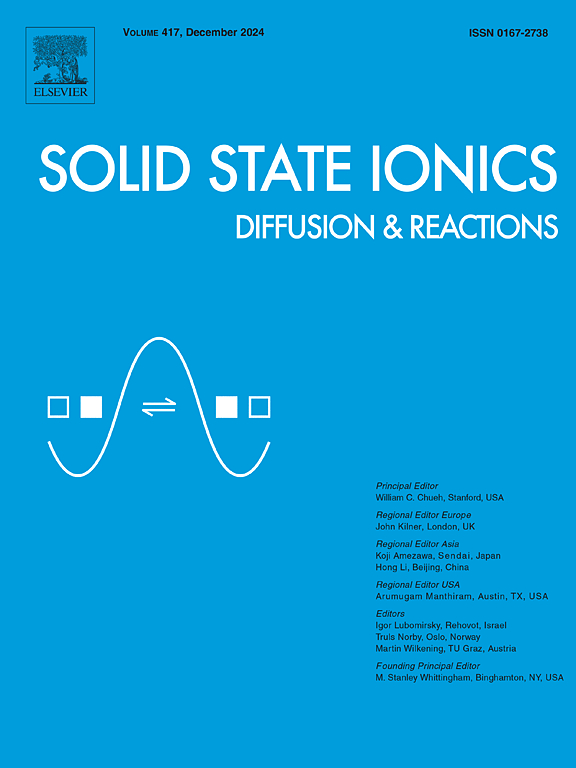Relationship between structure and room-temperature charge transport in highly acceptor-doped ceria and zirconia
IF 3.3
4区 材料科学
Q3 CHEMISTRY, PHYSICAL
引用次数: 0
Abstract
Even though mainly known for intermediate to high temperature applications, highly acceptor doped ceria and zirconia are potential candidates for use as proton conductive membranes or for electro-chemo-X devices, which requires comparably high ionic conductivity at room temperature. In this study, the composition La2Ce2O7, Y2Zr2O7 and La2Zr2O7 were prepared via Pechini synthesis, followed by calcination, pellet pressing and sintering. The received pellets were characterized by X-ray diffraction (XRD), X-ray pair distribution function analyses (XPDF), and Raman spectroscopy showing La2Zr2O7 as a pyrochlore, a global fluorite structure in Y2Zr2O7 and La2Ce2O7 as defective pyrochlore structure with local disorder. The investigation of electrical properties using classical electrochemical methods, such as electrochemical impedance spectroscopy (EIS), is constrained by very low electrical conductivity at room temperature for the investigated ceramics. To enable measurements at room temperature, and with a focus on the surface-near transport properties, a combination of Kelvin Probe Force Microscopy (KPFM) and local polarization-relaxation measurements has been employed in this study.
The application of KPFM-based polarization-relaxation measurements enabled the successful determination of diffusion coefficients in both dry and wet environments by employing positive or negative polarization voltages with highest values for the defective pyrochlore La2Ce2O7. Additionally, KPFM measurements were used to analyze the local potential distribution at the grain boundaries. The results are discussed in the context of a defect model.
高受体掺杂的氧化铈和氧化锆结构与室温电荷输运的关系
尽管主要用于中高温应用,但高度受体掺杂的二氧化锆和氧化锆是用作质子导电膜或电化学x器件的潜在候选者,这需要在室温下具有较高的离子电导率。本研究采用Pechini合成法制备了La2Ce2O7、Y2Zr2O7和La2Zr2O7组合物,然后进行了煅烧、球团压制和烧结。采用x射线衍射(XRD)、x射线对分布函数分析(XPDF)和拉曼光谱对所得到的球团进行了表征,结果表明:La2Zr2O7为焦绿石结构,Y2Zr2O7和La2Ce2O7为局部无序的缺陷焦绿石结构。由于所研究的陶瓷在室温下的电导率非常低,使用电化学阻抗谱(EIS)等经典电化学方法来研究电性能受到了限制。为了在室温下进行测量,并将重点放在表面附近的输运性质上,本研究采用了开尔文探针力显微镜(KPFM)和局部偏振弛豫测量的结合。利用kpfm极化弛豫测量方法,对有缺陷的焦绿石La2Ce2O7采用最高的正或负极化电压,成功地测定了干燥和潮湿环境下的扩散系数。此外,利用KPFM测量结果分析了晶界处的局部电位分布。在缺陷模型的上下文中讨论了结果。
本文章由计算机程序翻译,如有差异,请以英文原文为准。
求助全文
约1分钟内获得全文
求助全文
来源期刊

Solid State Ionics
物理-物理:凝聚态物理
CiteScore
6.10
自引率
3.10%
发文量
152
审稿时长
58 days
期刊介绍:
This interdisciplinary journal is devoted to the physics, chemistry and materials science of diffusion, mass transport, and reactivity of solids. The major part of each issue is devoted to articles on:
(i) physics and chemistry of defects in solids;
(ii) reactions in and on solids, e.g. intercalation, corrosion, oxidation, sintering;
(iii) ion transport measurements, mechanisms and theory;
(iv) solid state electrochemistry;
(v) ionically-electronically mixed conducting solids.
Related technological applications are also included, provided their characteristics are interpreted in terms of the basic solid state properties.
Review papers and relevant symposium proceedings are welcome.
 求助内容:
求助内容: 应助结果提醒方式:
应助结果提醒方式:


